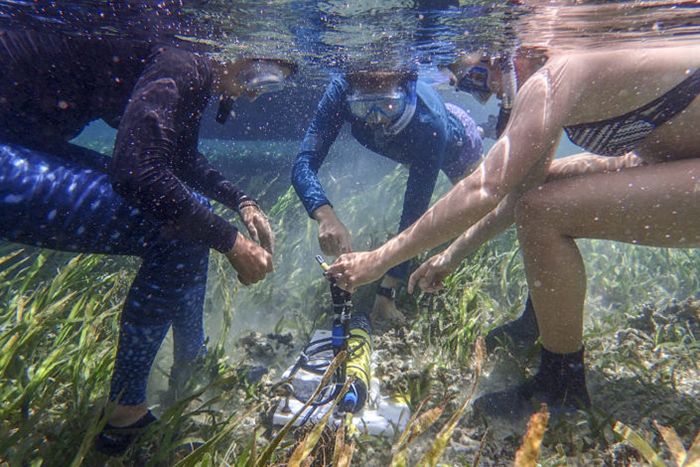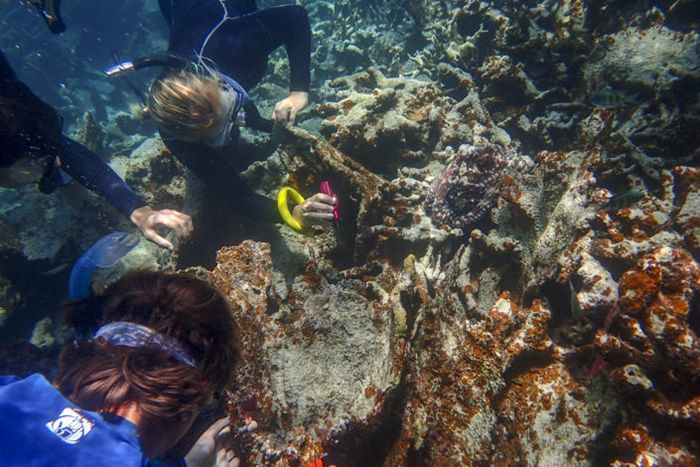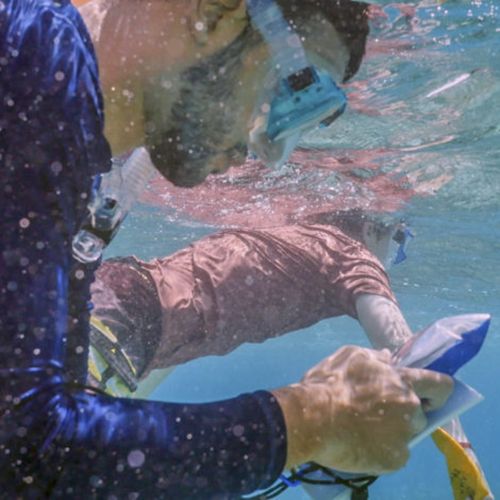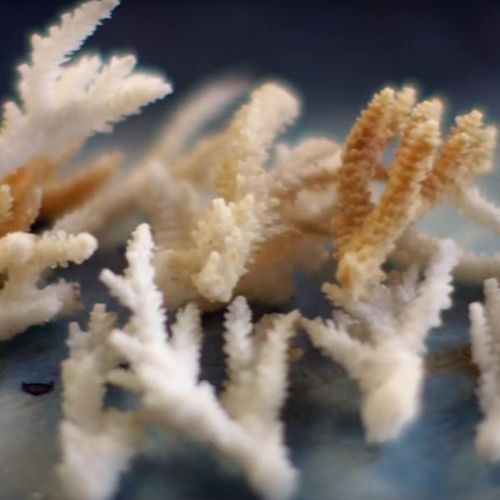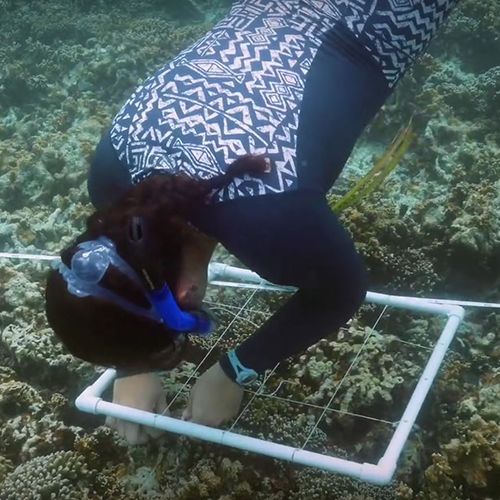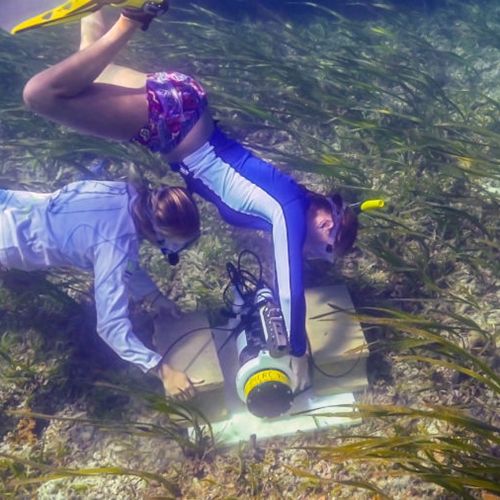Mornings in Koror, the capital of the Republic of Palau, offer a striking scene, as the sun reflects off limestone karst formations that jut out of the sea floor and lush tree-covered mountains that fill the horizon.
At daybreak, 18 Stanford undergraduates participating in the Bing Overseas Studies Program seminar Ecology and Management of Coral Reefs of Palau load snorkel gear onto speedboats that take them through a network of channels to different coral reef sites between the country’s 340 islands. From low-oxygen basins and tourist-trampled reefs to shallow lagoons and extremely hot environments, Palau hosts an assortment of ecosystems seldom found in such close proximity.
Palau boasts some of the clearest water on Earth and comprises part of the coral triangle, where reefs grow quickly, diversify into a cornucopia of shapes and colors and fight hard for survival. Unlike other parts of the world that are suffering the detrimental effects of ocean acidification and other human impacts, Palau hosts a range of coral sites, from struggling to thriving. And that makes it an ideal place for studying how humans are impacting the planet.
“Some of the places where we’re working are, in a way, the way of the future, the ocean of the future,” said Rob Dunbar, the W.M. Keck Professor in the School of Earth, Energy & Environmental Sciences (Stanford Earth). “Some of the inshore waters of Palau are both warmer and more acidic because of natural processes, so much so that the water today has chemical and thermal conditions like we expect many other reefs to experience after 100 years of global change.”
Dunbar, a professor of Earth system science, is one of the instructors for the seminar, offered every other year, that introduces students to interdisciplinary oceanography and the chemical, physical and biological interactions that drive the region’s biodiversity.
The curriculum is driven partly by the students, who are tasked with developing their own research projects and delivering results by the end of the three-week program. For some, it’s the first major research project they will conduct as undergraduates. It can be one of the most formative experiences during their time as undergraduates.
In the water every day
Program participants are based at the Palau International Coral Reef Center (PICRC), the nation’s leading marine research institution. Students complete required reading before arriving and during the first week of the program in Palau; they learn in classrooms about the physical, chemical, biological and ecological aspects of coral reefs, as well as how marine conservation works in the real world.
The lead instructors are Dunbar from Stanford Earth and Stephen Monismith, the Obayashi Professor in the School of Engineering. Other lecturers and researchers join parts of the program, including Steve Palumbi, the Jane and Marshall Steel Jr. Professor in Marine Sciences at Stanford’s Hopkins Marine Station; Jeremy Bailenson, the Thomas More Storke Professor of Communication at Stanford; and researcher Robert Richmond of the University of Hawai‘i and the Center for Ocean Solutions. Classroom sessions and afternoon field trips offer an interdisciplinary training to prepare the students to independently plan and develop their research projects.
After the first week, the professors embrace the motto “in the water every day.” Splitting off into different boats based on their project needs, students spend at least half the day exploring underwater ecosystems.
“I’ve been teaching in the field all my life and I have four field programs running at Stanford now,” Dunbar said. “To me, it’s almost impossible to understand what a coral reef is without seeing one – you can look at pictures, you can study theories of why coral reefs look the way they do, but it just doesn’t come close to having the impact of being there on site.”
The students come from diverse backgrounds, and while some were attracted to the program because of a previously established love of the ocean, others went snorkeling for the first time in Palau.
“I was blown away,” said Aiden McCarty, Biology ’19. “I’ve never experienced coral reefs myself before coming to Palau, and experiencing it with other Stanford students, seeing all the different coral species and not really knowing what they all are and what they do, was just incredible. You can’t get that kind of experience on Stanford’s campus.”
Learning through fieldwork about coral reefs, which Dunbar describes as “the Amazon rainforest of the ocean,” is a journey for the students. Puzzle pieces come together as they begin to understand how fish species interact with different habitats, why certain corals are competing with one another through marine chemical warfare, and how corals contribute to nutrient cycling and the greater oceanic ecosystem.
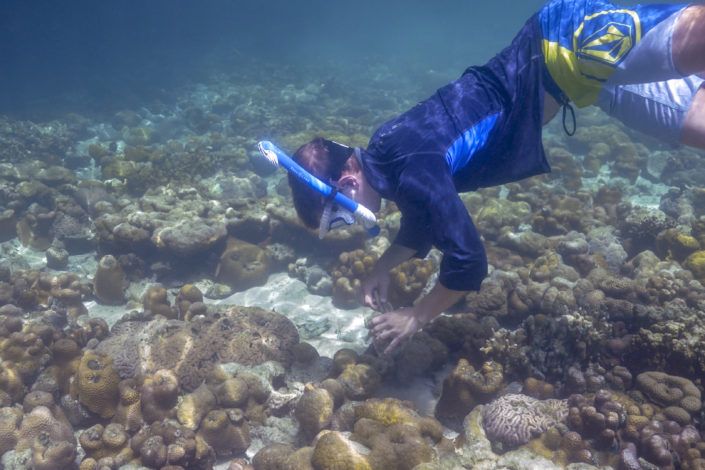
Undergraduate Alex McKeehan collects a sample for his coral density project. (Image credit: Kurt Hickman)
“This course creates an interactive mode of learning when we’re together in the field – we don’t have the distractions of the internet, Facebook, email, going from one class to the next where you’re constantly distracted,” Dunbar said. “We’re here together for this short period of time focused on one thing: the corals of Palau.”
